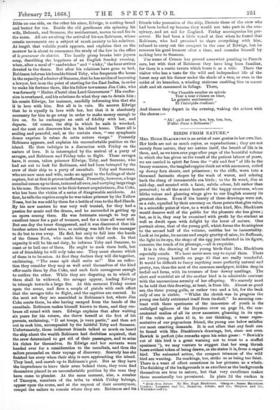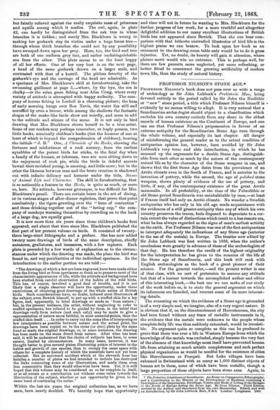BIRDS FROM NATURE.*
Mas. HUGH BLACKBURN is an artist of rare genius in her own line. Her birds are not so much copies, as reproductions ; they are not merely from nature, they are nature itself, the breath of life is in them, and, as we turn over page after page of the beautiful volume in which she has given us the result of the patient labour of years, we arc carried in spirit far from the "stir and fret" of life to the breezy common, the tangled coppice thick set with anemones, coiled up downy fern shoots, and primroses ; to the cliffs, worn into a thousand fantastic shapes by the wash of waves, and echoing back the clang of innumerable sea birds ; to the fir wood, dim at mid-day, and scented with a faint, subtle odour, felt rather than perceived ; to all the secret haunts of the happy creatures, whose blithe voices and glancing wings give to our English scenery its greatest charm. Even if the beauty of these drawings were not, as a rule, equalled by their accuracy on those points that give value, in a scientific point of view, to a work of this kind, Mrs. Blackburn would deserve well of the public for the pleasure she has given ; but, as it is, they may be examined with profit by the student as well as dwelt upon with delight by the lover of nature. One portrait alone, that of the young gull, which forms the frontispiece to the second half of the volume, entitles her to immortality. Look at its poise, its serene and empty gravity of mien, its fluffiness, the light in its eye, the shape of the egg just indicated in its figure, examine the touch of its plumage,—all is exquisite.
It is in the drawing of her young birds that Mrs. Blackburn especially excels. We have never seen any to equal them. There are two young kestrils on page 45 that are really wonderful. It would be difficult to fancy anything more perfectly natural and pretty, too, than the nest of the common sandpiper, hidden deep in trefoil and ferns, with its treasure of four downy nestlings. The alert and watchful air of the mother bird is in admirable contrast with the unconscious serenity of her offspring. We scarcely need to be told that this drawing, at least, is from life. Almost as good are the three young gulls, or rather two and a bit, for the beak only of one is visible. " Whilst the sketch was in progress the young one fairly extricated itself from its shell." In amusing con- trast with these specimens of the innocence of youth is the unfledged ugliness of the Royston crow on page 34, the con- centrated malice of all its crow ancestors gleaming, in its eyes. If the robin on plate 41 is, to our thinking, a tame repre- sentative of our pugnacious friend, the young one below satisfies our most exacting demands. It is not often that any fault can be found with Mrs. Blackburn's drawings, but, since not even Bewick is perfect (she remarks upon his solan goose : " Bewick's
cut of this bird is a great warning not to trust to a stuffed specimen "), we may venture to suggest that her song thrush bears evident token of being drawn, as she states it is, from a caged bird. The animated action, the compact trimness of the wild bird are wanting. Its markings, too, strike us as being too faint.
There is a want of effect sometimes in her pictures as a whole. The finishing of the backgrounds is as excellent as the backgrounds themselves are true to nature, but that very excellence makes them occasionally too prominent. In plate 32 the cuckoo is
* Birds from Nature. By Mrs. Hugh Blackburn. Glasgow: James Haciehoaa. London: Longman and Co., Hamilton, Adams, and Co., Simpson and Co., Whittaker and Co. but faintly relieved against the really exquisite mass of primroses and squills among which it nestles. The owl, again, in plate 42, can hardly be distinguished from the oak tree in whose branches it is hidden ; and surely Mrs. Blackburn is wrong in Making her goshawk slay its victim under a huge forest tree— through whose thick branches she could not by any possibility have swooped down upon her prey. Here, too, the bird and tree are both of one uniform grey tint, and rather undistinguishable one from the other. This plate seems to us the least happy of all her efforts. One of her very best is on the next page, a head of the same goshawk drawn on a larger scale, and contrasted with that of a kestril. The pitiless ferocity of the goshawk'i eye and the carriage of the head are admirable. As a specimen of Mrs. Blackburn's skill at foreshortening, take the swimming guillemot at page 5,—where, by the bye, the sea is chalky—or the solan geese fishing near Ailsa Craig, where every variety of attitude is attempted with happy audacity. The com- pany of herons fishing in Locheil is a charming picture; the haze of early morning hangs over Ben Nevis, the water lies still and unruffled by even a breeze, while among the shallows the fantastic shapes of the snake-like birds show out weirdly, and seem to add to the solitude and silence of the scene. It is not only in bird drawing that Mrs. Blackburn shows herself to be a true artist. Some of our readers may perhaps remember, or haply possess, two little books, nominally children's books (but the humour of one at least of which is beyond the comprehension of children), bearing the initials " J. B." One, A Chronicle of the Rooks, showing the fortunes and misfortunes of a rook nursery, from the earliest squabbles of the parent birds for sticks, to the fatal day when a family of the human, or inhuman, race are seen sitting down to the enjoyment of rook pie, while the birds in doleful accents bewail their ravished young, is amusing, and little more ; but in the other the likeness between man and the brute creation is shadowed out with infinite delicacy and humour under the title, Scenes of Animal Life and Character. The skill in foreshortening, that is so noticeable a feature in the Birds, is quite as much, or more so, here. No attitude, however grotesque, is too difficult for Mrs. Blackburn's pencil. There are certain bears in the act of dining, or in various stages of after-dinner repletion, that prove that point conclusively ; the tigers growling over the " bone of contention " and those drinking together out of the " loving cup," the com- pany of monkeys warming themselves by crowding on to the back of a large dog, are equally good.
It is now more than six years since these children's books first appeared, and about that time since Mrs. Blackburn published the first part of her present volume on birds. It consisted of twenty- three large-sized lithographs and a preface. She has now added twenty more drawings of birds of the same description, chiefly natatores, grallatores, and insessores, with a few raptores. Each plate is preceded by a few words of explanation as to the circum- stances under which the drawing was made, the place the bird was found in, and any peculiarities of the individual specimen. In the introduction to the earlier portion we are told :— " The drawings, of which a few are here engraved, have been made either from the living bird or from specimens so fresh as to preserve most of the characteristic appearances of life, while the attitude and background have been studied from careful observation of the habits of the wild birds. This has, of course, involved a good deal of trouble, and it is not likely that a single observer will have the opportunity, under these restrictions, of obtaining good drawings of the whole series of British birds. Such considerations have, no doubt, induced most illustrators of the subject, even Bewick himself, to put up with a staffed skin for a lay figure, and, apparently, to label drawings so made as from nature ;' but, in the present instance, the artist, without neglecting to refer to stuffed specimens, has refused to be guided by them, in the belief that drawings really from nature (and such only) may be made to give a representation of nature more faithful, in most essential points, than the stuffed skin itself. . . . In order to carry out the same idea of interposing as few interpreters as possible between nature and the actual print, the drawings have been copied on to the stone (or zinc) plate by the same hand as made the original drawings, or, in some instances, the drawing has been made on the stone direct from nature. After what has been said, it will be understood that the choice of subjects has been, to some extent, limited by circumstances. In many cases, however, it was thought better to give several plates illustrating points of interest in the habits and growth of one species, than to occupy the same space with others for a complete history of which the materials have not yet been collected. But an untoward accident which at the eleventh hour has befallen a number of plates we had intended to include has destroyed the links connecting some of our illustrations, and made them even less consecutive than they would otherwise have been. Yet, it is still hoped that this volume may be considered as so far complete in itself, or at all events as a contribution not without some value towards the illustration of the subject, whether or not opportunity be given to the same hand of continuing the series."
Within the last six years the original collection has, as we have seen, been nearly doubled. We heartily hope that opportunity and time will not in future be wanting to Mrs. Blackburn for the further progress of her work, for a more truthful and altogether delightful addition to our many excellent illustrations of British birds has not appeared since Bewick. That she can bear com- parison with that hitherto unrivalled illustrator of bird life is the highest praise we can bestow. To look upon her book as an ornament to the drawing-room table only would be to do it gross injustice. Yet, no doubt, its beauty will gain it attention, where plainer merit would win no entrance. This is perhaps well, for there are few pursuits more neglected, yet more refreshing, or better fitted to counteract the growing artificiality of modern town life, than the study of natural history.



































 Previous page
Previous page